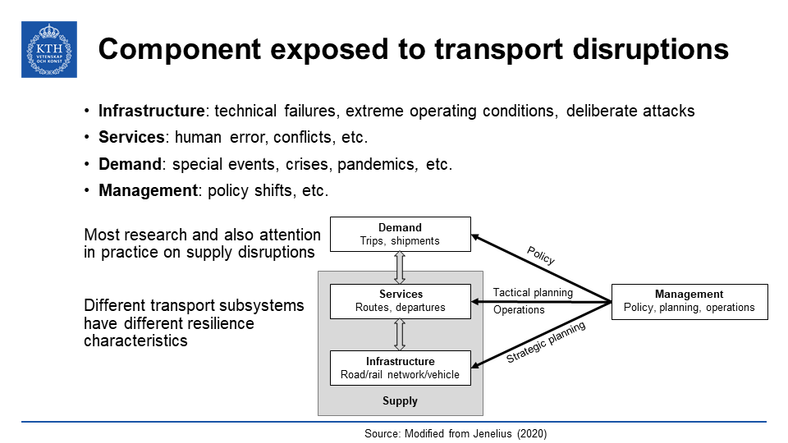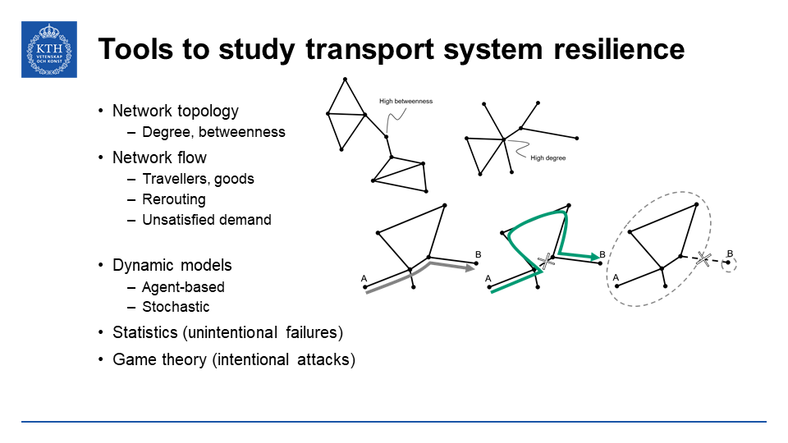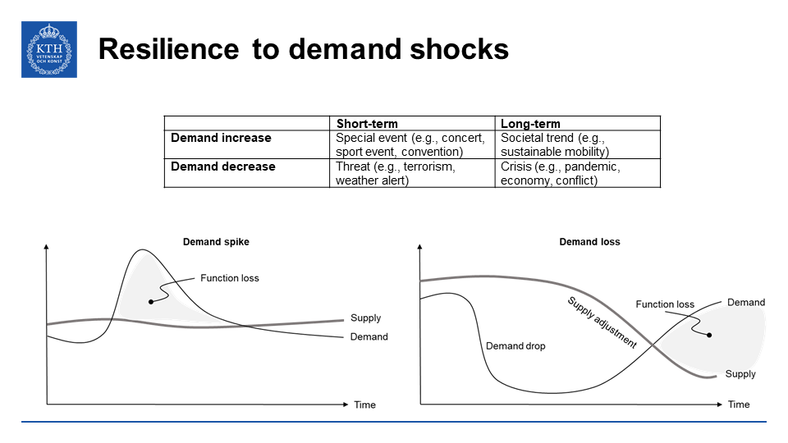Transport system resilience
Case description
An enduring research interest of Erik Jenelius is the resilience of the transport system, that is, the ability of the system to withstand, adjust to, and recover from disruptive events. Such events may stem from, e.g., technical failures, extreme weather or antagonistic attacks. Climate change is increasing the frequency and severity of extreme weather events such as flash floods, forest fires and hurricanes, which put the transport infrastructure under severe pressure. Further, as travel demand in urban areas increases, congestion not only reduces the efficiency of the system under normal conditions, but also makes it more sensitive to both minor and major disturbances. An important aspect of Jenelius' research has therefore been to quantify the impacts of road and public transport network disruptions for the travelers and to develop practically relevant ways to analyze the results.

Starting from 2006, Jenelius has published a series of articles and book chapters that conceptualize, implement and apply resilience analyses of transport systems. The first paper, Jenelius et al. (2006), develops and applies some fundamental metrics of road network vulnerability. It has become a seminal contribution to the field of transport network resilience. In 2018, the paper was ranked as one of ten “Classic Papers in Transportation” by Google Scholar.

The most recent contribution, Jenelius (2022), proposes a conceptual framework of transport resilience that includes both supply and demand disruptions, and uses the Covid-19 pandemic as example of the latter. Other studies have considered regional disparities (Jenelius, 2009) and equity aspects (Jenelius, 2010) of network vulnerability, resilience of public transport networks (Cats and Jenelius, 2015, 2018; Jenelius and Cats, 2015), modelled area-covering disruptions (Jenelius and Mattsson, 2012), and synthesized existing research (Mattsson and Jenelius, 2015; Jenelius and Mattsson, 2021).

Impact
Jenelius' work is featured prominently in the report Transport System Resilience by OECD International Transport Forum. Aspects of the methodological framework have also been included in the Swedish official analysis method and cost-benefit parameter values, ASEK.
All in all, Jenelius' publications in the field have generated more than 3000 citations according to Google Scholar.
References
Cats, O. & Jenelius, E. (2014). Dynamic Vulnerability Analysis of Public Transport Networks : Mitigation Effects of Real-Time Information. Networks and Spatial Economics, 14(3-4), 435-463.
Jenelius, E., Cats, O. (2014). The Value of New Cross-Radial Links for Public Transport Network Robustness. In Vulnerability, Uncertainty, and Risk: Quantification, Mitigation, and Management - Proceedings of the 2nd International Conference on Vulnerability and Risk Analysis and Management, ICVRAM 2014 and the 6th International Symposium on Uncertainty Modeling and Analysis, ISUMA 2014. (pp. 638-647). American Society of Civil Engineers (ASCE).
Cats, O. & Jenelius, E. (2015). Planning for the Unexpected: The Value of Reserve Capacity for Public Transport Network Robustness. Transportation Research Part A : Policy and Practice, 81, 47-61.
Cats, O. & Jenelius, E. (2018). Beyond a complete failure: The impact of partial capacity degradation on public transport network vulnerability. Transportmetrica B : Transport Dynamics, 6(2), 77-96.
Jenelius, E. (2009). Network structure and travel patterns : explaining the geographical disparities of road network vulnerability. Journal of Transport Geography, 17(3), 234-244.
Jenelius, E. (2010). User inequity implications of road network vulnerability. Journal of Transport and Land Use, 2(3/4), 57-73.
Jenelius, E. (2010). Redundancy importance : Links as rerouting alternatives during road network disruptions. In Procedia Engineering. (pp. 129-137).
Jenelius, E. (2022). Rail transport resilience to demand shocks and COVID-19. I Rui Calçada and Sakdirat Kaewunruen (Red.), Rail Infrastructure Resilience: A Best-Practices Handbook ( (1 uppl.) s. 65-79). Elsevier.
Jenelius, E. & Cats, O. (2015). The value of new public transport links for network robustness and redundancy. Transportmetrica A : Transport Science, 11(9), 819-835.
Jenelius, E. & Mattsson, L.-G. (2012). Road network vulnerability analysis of area-covering disruptions : A grid-based approach with case study. Transportation Research Part A : Policy and Practice, 46(5), 746-760.
Jenelius, E. & Mattsson, L.-G. (2015). Road network vulnerability analysis : Conceptualization, implementation and application. Computers, Environment and Urban Systems, 49, 136-147.
Jenelius, E. & Mattsson, L.-G. (2021). Resilience of transport systems. I Roger Vickerman (Red.), International Encyclopedia of Transportation ( (1 uppl.) s. 258-267). Elsevier.
Jenelius, E., Petersen, T. & Mattsson, L.-G. (2006). Importance and exposure in road network vulnerability analysis. Transportation Research Part A : Policy and Practice, 40(7), 537-560.
Mattsson, L.-G. & Jenelius, E. (2015). Vulnerability and resilience of transport systems : A discussion of recent research. Transportation Research Part A : Policy and Practice, 81, 16-34.
Tympakianaki, A., Koutsopoulos, H. N., Jenelius, E. & Cebecauer, M. (2018). Impact analysis of transport network disruptions using multimodal data : A case study for tunnel closures in Stockholm. Case Studies on Transport Policy, 6(2), 179-189.